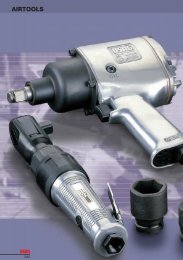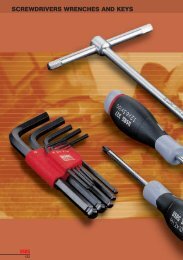Industrial seal self study guide - SKF.com
Industrial seal self study guide - SKF.com
Industrial seal self study guide - SKF.com
Create successful ePaper yourself
Turn your PDF publications into a flip-book with our unique Google optimized e-Paper software.
Testing for the Presence of Machine Lead<br />
Testing the shaft surface for machine lead can be done simply and with<br />
a minimum of tools. The most effective method requires a 36 inch<br />
(914.4mm) length of cotton quilting thread, a one ounce weight and<br />
silicone oil.<br />
Mount the shaft in a chuck so the shaft surface is level. Lightly coat the<br />
shaft with oil. Suspend the weight on the thread as shown here.<br />
Rotate the shaft at approximately 60 rpm. If the thread moves along<br />
the shaft, machine lead is present (fig. 7g).<br />
Bore Requirements<br />
The lead corner, or entering edge, of the bore should be chamfered<br />
with a 15/30 degree angle and free of burrs. The inside corner of the<br />
bore should have a maximum radius of .031 (.79mm). This will help<br />
prevent <strong>seal</strong> damage during installation. Chamfer length should be<br />
.060” to .090” (1.50 to 2.29mm); see fig. 7h.<br />
Bore Tolerance<br />
Similar to shafts, the inch (RMA) system for <strong>seal</strong> bores also uses<br />
a “floating” range based on the nominal diameter plus or minus<br />
some value depending on the base size. With the metric (ISO)<br />
standard however, the tolerances for bores (typically ISO H8) are<br />
applied as a plus value/minus zero. Unlike shafts and <strong>seal</strong> lips, the<br />
bore fit for <strong>seal</strong>s can be significantly affected by the tolerance applied<br />
to the hardware. For the best results, the correct bore diameter<br />
for the tolerance system used should always be observed.<br />
Refer to the <strong>SKF</strong> Handbook of Seals for tolerance data and further<br />
information on housing bores.<br />
Bore Hardness<br />
No specific Rockwell hardness is re<strong>com</strong>mended. Bore hardness need<br />
only be high enough to maintain interference with the <strong>seal</strong>’s outside<br />
diameter.<br />
Bore Material<br />
Ferrous and other <strong>com</strong>monly used metallic materials (like aluminum)<br />
are acceptable for the bore. Bore material must be <strong>com</strong>patible with the<br />
<strong>seal</strong> type used; if an aluminum bore is used, thermal expansion may<br />
have to be considered.<br />
Testing the shaft surface for machine<br />
lead is a simple process requiring a<br />
minimum of tools (fig. 7g).<br />
(fig. 7h)<br />
FINISH 100 microinch<br />
OR LESS<br />
Ra<br />
(2.5 micrometer)<br />
R .031<br />
(0.79 mm)<br />
.060 - .090<br />
(1.52 - 2.229 mm)<br />
15-30<br />
7<br />
63







